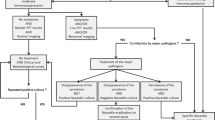Summary
Staphylococcus aureus is usually the first bacterial pathogen detected in the respiratory secretions of patients with cystic fibrosis. This review briefly examines the characteristics of this host-parasite relationship in terms of current knowledge about the toxicity of the organism, mechanisms of respiratory tract injury, therapy and prevention. Recent evidence indicates that viral infection plays a role in the initial damage of the respiratory epithelial cells and staphylococcal colonization ensues. Affinity of staphylococcus for cystic fibrosis mucus, mucociliary abnormalities and unknown factors contribute to persistent colonization with this organism causing progressive pulmonary damage and possibly influencing Pseudomonas infection. Most of the evidence today indicates that aggressive antibiotic management directed againstS. aureus is warranted in all stages of bronchopulmonary infection in cystic fibrosis. Future efforts to prevent colonization and the toxic and immunopathic consequences of staphylococcal infection are also important. One study is in progress that examines antibiotic prevention in the early stages of cystic fibrosis. Future investigations need to address other strategies including vaccines, antitoxins, anti-inflammatory agents, immunomodulators, and antibiotic regimens.
Zusammenfassung
Staphylococcus aureus ist in der Regel der erste bakterielle Erreger, der bei Patienten mit zystischer Fibrose in den Atemwegssekreten nachgewiesen wird. In der folgenden Übersicht wird diese Beziehung zwischen Wirtsorganismus und Besiedler nach dem neuesten Forschungsstand zur Toxizität des Erregers, Mechanismen der Atemwegsschädigung, Therapie und Prävention dargestellt. Nach neuesten Forschungsergebnissen spielt die Virusinfektion für die initiale Schädigung des Atemwegsepithels eine Rolle, die Staphylokokken-Kolonisation folgt nach. Die persistierende Kolonisation mit diesem Erreger wird unterhalten durch die Affinität der Staphylokokken zum Schleim bei zystischer Fibrose, durch mukoziliare Störungen und weitere unbekannte Faktoren. Daraus entwickelt sich eine fortschreitende Schädigung der Lungen, Einflüsse auf die Pseudomonas-Infektion sind möglich. Die überwiegende Zahl der verfügbaren Forschungsergebnisse spricht dafür, daß in allen Stadien der bronchopulmonalen Infektion bei zystischer Fibrose eine aggressive antimikrobielle Therapie gegenS. aureus erforderlich ist. Weitere Maßnahmen zur Verhütung der Kolonisation und der toxischen und immunpathogenetischen Folgen der Staphylokokken-Infektion sind ebenfalls wichtig. In einer derzeit laufenden Studie wird die Antibiotkaprophylaxe in frühe Stadien der zystischen Fibrose geprüft. Andere Strategien wie Vakzinen, Antitoxine, entzündungshemmende Substanzen, Immunmodulatoren und Antibiotikaregime müssen wissenschaftlich geprüft werden.
Similar content being viewed by others
References
Huang, N. N., Schidlow, D. V., Szatrowski, T. H., Palmer, J., Laraya-Cuasay, L. R., Yeung, W. et al. Clinical features, survival rate, and prognostic factors in young adults with cystic fibrosis. Am. J. Med. 82 (1987) 871–879.
Marks, M. I. The pathogenesis and treatment of pulmonary infections in patients with cystic fibrosis. J. Pediatr. 98 (1981) 173–179.
Albus, A., Fournier, J. M., Wolz, C., Boutonnier, A., Ranke, M., Hoiby, N. et al. Staphylococcus aureus capsular types and antibody response to lung infection in patients with cystic fibrosis. J. Clin. Microbiol. 26 (1988) 2505–2509.
Abman, S. H., Ogle, J. W., Butler-Simon, N., Rumack, C. H., Accurso, F. J. Role of respiratory syncytial virus in early hospitalizations for respiratory distress of young infants with cystic fibrosis. J. Pediatr. 113 (1988) 826–830.
Ramphal, R.: The role of bacterial adhesion in cystic fibrosis. Fourth European Congress of Clinical Microbiology, Acropolis-Nice 1989, Abstract No. # 212/0S11, 10 p. 108.
Loening-Baucke, V. A., Mischler, E., Myers, M. G. A placebo-controlled trial of cephalexin therapy in the ambulatory management of patients with cystic fibrosis. J. Pediatr. 95 (1979) 630–637.
Bauernfeind, A., Matthias, Ch., Otto, U.: Antibiotic susceptibility of staphylococci from cystic fibrosis (CF) patients. Fourth European Congress of Clinical Microbiology, Acropolis-Nice 1989, Abstract # 214/0S11,10 p. 109.
Shalit, I., Berger, S. A., Gorea, A., Frimerman, H. Widespread quinolone resistance among methicillin-resistantStaphylococcus aureus isolates in a general hospital. Antimicrob. Agents Chemother. 33 (1989) 593–594.
Guggenbichler, J. P., Ellemunter, H.: The role of antistapphylococcal antibiotics in cystic fibrosis. Fourth European Congress of Clinical Microbiology, Acropolis-Nice 1989, Abstract # 217/0S11,10 p. 110.
Hollsing, A. E., Granstrom, M., Strandvik, B. Prospective study of serum staphylococcal antibodies in cystic fibrosis. Archiv. Dis. Childh. 62 (1987) 905–911.
Author information
Authors and Affiliations
Additional information
Supported by Merrell Dow Pharma GmbH, Rüsselsheim, FR Germany.
Rights and permissions
About this article
Cite this article
Marks, M.I. Clinical significance of Staphylococcus aureus in cystic fibrosis. Infection 18, 53–56 (1990). https://doi.org/10.1007/BF01644186
Issue Date:
DOI: https://doi.org/10.1007/BF01644186



